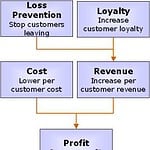These days, many of my clients (and in fact businesses in general) are aware of the relevance and benefits of retaining their current customers. After all, it costs 5 to 6 times more to acquire a new customer than retain an existing one!
However, many businesses do not understand the impact that the Call Centre can have on ensuring that this strategic objective is realised. When I talk to clients about their customer attrition problems, I ask them if they are “making every call count”?
Most of them take a few moments to ponder the question and then nine times out of ten they respond by advising that they think they do, but are not entirely sure!
My investigations always offer up further opportunities for best practice success at ensuring that every contact with the customer through the Contact Centre is really helping to retain their current customers.
So here are 9 hot tips that you can instigate in your Call Centres ‘Business as Usual’ activities to help retain your current customers and ultimately increase your ROI values!
- Really listen to the customer
- Speak the customer’s language
- Offer what the customer wants
- Servicing your customer beyond expectations
- Acknowledging signs that the customer is not happy and might attrite
- Offering solutions to stop them leaving
- Following up when you say you will
- Acknowledging customer milestones or relevant occurrences
- Putting yourself in the customers position
1. Really listen to the customer
How many times have you dealt with a Contact Centre where the customer service repetitive (CSR) has not really listened to your conversation or has interjected whist you have been talking?
From my perspective it happens all too often and is really an unpleasant experience.
Many Contact Centres have strong KPI targets set around average call lengths, which in turn can lead to the CSR’s rushing through calls and not taking the time out to really listen and understand the customers’ needs.
Occasions where the CSR is not really understanding the problem can be easily resolved by the proven process of the CSR repeating the callers concerns/issue or questions as part of the usual interaction.
This is called active listening and is the old story of getting your CSR’s to slow down, listen, repeat, confirm and respond!
Of course the other golden rules is to always train and encourage your CSR’s to never talk over a caller whilst they are dealing with them!
2. Speak the customer’s language
I worked with a FMCG company awhile back that sold and serviced highly technical products. Over a period of time they noticed an increase in their customer attrition. They engaged Genroe to help them discover why their customers were leaving, and to implement initiatives to reduce these occurrences.
As part of the gap analysis it was discovered that the Contact Centre CSR’s were doing the customers an injustice when selling products and servicing their needs, which was driving customer attrition.
The injustice was in terms of bamboozling the customers with too much technical information, and in-house terminology. This meant the customers became confused and embarrassed during the call because they did not really understand what the CSR’s were talking about.
The golden rule in these cases is to make sure your CSR’s are talking to your customers in their own terms (unless dealing with a technically capable person) so that the customer becomes empowered and understands what is being talked about.
The Company acknowledged this issue and agreed to implement our suggested initiative of “talking in real terms”.
Once in place the Company realised a direct decrease of 1.5% in customer attrition from this initiative alone, a winning formula in anyone’s books!
3. Offer what the customer wants
Here is a classic example I had the other day dealing with an accommodation provider.
I had shot off a “request information” email to a company asking if they could come back to me and advise the cost and availability of a one bedroom unit & a one bedroom + study unit for an intended stay.
I was very impressed when I received a return email in a matter of minutes (as I had emailed them outside of usual business hours) but was pretty disappointed when I opened it up and read the content.
They responded and advised the price of a two bedroom unit and did not even include availability information. Needless to say I went elsewhere for my needs.
This scenario is replicated by many companies . Often the marriage between what the customer needs, wants or could be interested in are mismatched and results in no transaction or total loss of the sale.
Getting the fundamentals right in terms of matching the customer’s requirements ensures reduced customer attrition.
See the second article in this series to read about servicing your customer beyond expectations, acknowledging that the customer is not happy and save initiatives.
My Free Return on Customer Retention Calculator accurately estimates the value of customer retention Download Here4. Servicing your customer beyond expectations
Do you currently exceed your customer’s service expectations?
Using Service Level Agreements (SLA’s) and providing good old fashioned customer service are powerful tools to help retain customers.
SLA’s can be measured against a number of key attributes in any Contact Centre, including, Speed of answer, Issue resolution times and service provision.
All of these areas are where customer’s expectations can readily be exceeded by not only the measurement of success but also the provision of best practice service.
Imagine calling a company, not having to wait in queue to be answered, being served by a CSR that engaged with you, understood your needs, provided great service, sold you products that were applicable to you, and generated solutions to problems; and the list goes on.
Wouldn’t that be a great experience every time you transacted with an organisation!
Does this happen with every contact that’s made to your Contact Centre?
If not start putting plans and strategies in place that will ensure it does, and if you are unsure of how to do this or were to start, talk to us here at Genroe as we are 100% confident that we will be able to offer you solutions.
After all a happy customer is more likely to bring in free referral business, generate good word-of-mouth publicity and remain loyal for longer.
5. Acknowledging signs that the customer is not happy and might attrite
Customers are pretty transparent when they are talking to your CSR’s if they are not happy with your company’s services.
Usually the language and syntax they use is quite probing, questioning and abrupt.
Also, customers that have reoccurring issues or are still waiting on satisfactory resolutions are likely candidates to become non-customers.
Being able to identify and acknowledge when a customer is likely to be thinking about leaving your business is a powerful tool to be able to decrease customer attrition.
Are your CSR’s trained and supported to recognise these situations and respond accordingly?
I recently worked with a major financial institution where there was an opportunity to support their CSR’s in identifying these types of scenarios.
Our solution was to provide a suite of training tools for their CSR’s to be able to recognise the possible attrition of customers by the use of their language and syntax during their conversations as well as trigger occurrences that the customers may have been exposed to that would also prompt the loss of their business.
The training program for the CSR’s was twofold:
1) Identify language and syntax scenarios that rang alarm bells from possible “leavers” and how to turn these situations around
2) Providing workable and appropriate save solutions that could be offered to the customer to decrease occurrences of possible attrition (read on to the next point to learn more about Save Initiatives)
The results from this program were very impressive with a reduction in customer attrition by 2.5% through the use of these tools.
6. Offering solutions to stop them leaving (Save initiatives)
Reducing customer attrition through the use of tools such as “Save initiatives” is an exciting subject that could have its own article dedicated to it.
However I will give you a quick overview of a couple of scenarios that have successfully aided businesses which I have supported.
Firstly there are two types of save initiatives: proactive and reactive.
Proactive initiatives are undertaken before a customer has left your business and are orchestrated as a reaction to subtle triggers that the customer is displaying that lead you believe he/she may be looking to move away from your business. For example, a customer that has recently met the average lifetime value of your customer base could be considered in risk of leaving so you may wish to acknowledge that customer for their custom.
Reactive initiatives are driven as a direct result of the customer advising that they are leaving your business. For example, it could be an offer of a discount if they retain their business with your company.
Save initiatives can be as complex or as simple as you want or need them to be, but the implementation of any save initiative within a business and particularly via its Contact Centre operations is a positive step in helping reduce customer attrition.
Best practice organisations have comprehensive Save initiatives with dedicated budgets and empower their CSR’s to be able to offer services/products/discounts as needed to retain customers.
Companies that are starting out on Save initiative journey can start with simple things like sending a voucher to customers that are reaching the customer average live time value or have not transacted with them for an extended period of time.
7. Following up when you say you will
How often have you not been called back by a Company when they advised that they would do so?
Recently I had a very positive experience from a Company that I was thinking about parting ways with as a customer. I had called to clarify some information and asked for advice. The CSR was very helpful and offered to resolve my query once she had reviewed my customer file and would get back to me by a nominated time. At this stage the company had no inkling of my desire not to remain loyal to them.
Ten minutes after finishing the call I received a return call from the original CSR advising that she would not be able to come back to me with an answer in the nominated time as she had to review archived files and gave me another target time that she would call me back by with a final answer.
She did so within the nominated time period and not only provided the answers and information I needed, but also offered other solutions to my problem.
I must admit that my faith in the Company was restored and I still remain a loyal customer.
Ensuring that you call customers back, and within nominated time periods will mean customers will be content with your service and will stay loyal.
Tune in next time for the last instalment in this post when we will discuss acknowledging customer milestones and putting yourself in the customer’s position.
8. Acknowledging customer milestones or relevant occurrences
One of the most powerful tools for any organisation is the personalisation and acknowledgement of specific customer milestones or events that the customer has achieved.
Examples can be as basic as:-
- Mr Smith thanks for your custom over the last 2 years we really appreciate it… or
- Fay I’ve just noticed it’s your anniversary of dealing with us this month, thank you for being such a loyal customer… or
- Happy birthday Ben for Wednesday as our records show that it’s coming up….
Or as complex as:-
- Ms Dune as you have purchased over $1000 worth of goods from us in the last 2 months I would like to extend a….. or
- John I see that your last order was not dispatched on time, therefore I would like to extend a 5% discount to you on this purchase for the inconvenience caused…
Using customer data, insights, and acknowledging these to the customer gives the customer a great sense of belonging to your organisation and a strong sense that you care about their custom.
In these days of customers having many more choices of suppliers, competition increasing and price not necessarily being the only motivator, acknowledging the customers’ contribution to your organisation will keep them with you for longer periods of time.
As a side note a client was extremely excited about following these principals when we identified that it was a gap in their operations. However, they were very concerned as they didn’t have CRM systems or large data pools as an enabler to identify some of the key attributes of their customers milestones. Our advice was to start small and to immediately introduce data capture content in each call.
Their first initiative was to open the call (where applicable) by thanking their customers for their past custom (obviously they had purchased before).
Over a 12 month period of time (and with the adoption of further data fields and information being captured) the life time value of their customer rose from an average of 9 months to 15 months, and it still climbing upwards.
You can estimate the increase in customer value using a tool as simple as the return on retention estimator to understand the positive ramifications and value that this is bringing to the business!
9. Putting yourself in the customers position
One word empathy!
The Australian addition of the Oxford dictionary describes the meaning of the word empathy as “the ability to identify oneself mentally with a person or thing and so understand his/her feelings or its meaning”
Think for a moment of a time when you have called a company with an issue that was making you quite grumpy. Now how would it be if the person on the other end of the phone showed no interest in helping you with your issue or had no appreciation how the issue had affected you.
If you’re like me you wouldn’t be sticking around as a loyal customer.
In my dealings with many organisations there are often opportunities for the Contact Centre staff to be more empathetic towards the customer’s needs and in doing so reduce the likely hood of them moving away from the business.
Emotional Intelligence (EI) training is quite often forgotten as part of the overall mix of training modules, with many organisations concentrating on product, systems and other soft skills.
However empowering your people to be able to identify with a customer’s issues or concerns, and giving them the tools to be able to understand scenarios from the customers perspective is powerful stuff.
A customer that receives a genuine emphatic response from a business will have a stronger probability of staying with that business as they feel needed and respected.










